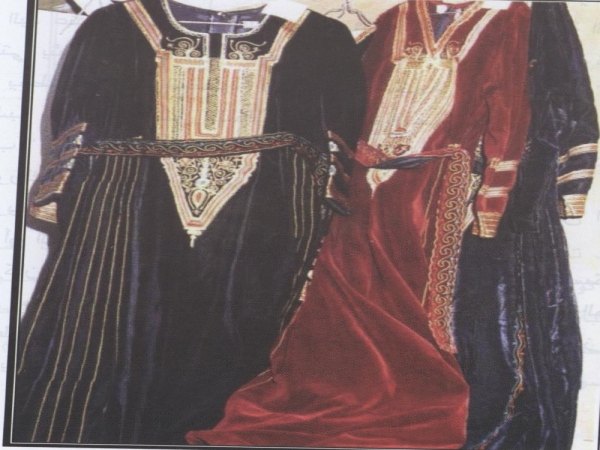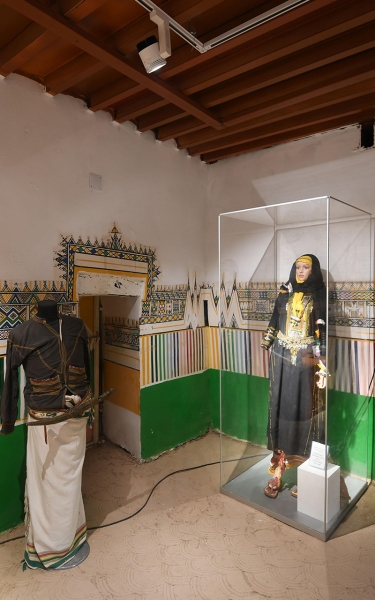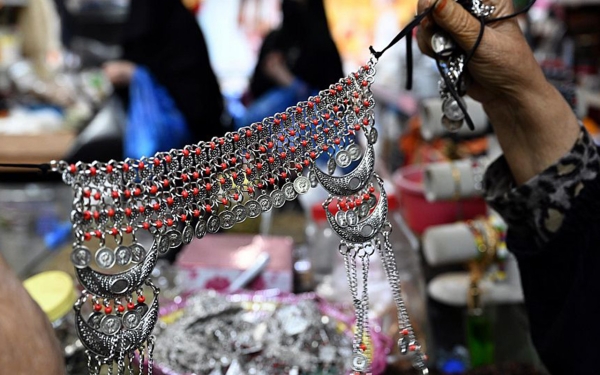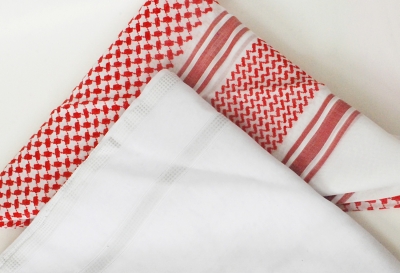



Traditional Garments in Aseer Province refer to the clothing associated with the customs and traditions of men and women in Aseer Province, south of the Kingdom of Saudi Arabia, as they are a rooted part of the popular cultural legacy of the province.
In the past, several types of clothes were popular in Aseer according to environmental and climatic conditions, starting from the difference in the landscapes to the temperature which varied from one place to another. Clothes were made of either light or heavy fabrics, and some men's and women's garments had distinguished colorful and decorated designs.
Traditional men's garments in Aseer Province
Men's garments in Aseer differed in their designs, colors, and fabrics. Popular traditional clothes were worn on special occasions, at work, or daily, such as Muzayyal, men's Abaya, different forms of Izaar, Muthawlak, Mufraj, and Mubrim.
Muzayyal was famous in Aseer Province. It is a short and loose thobe with long sleeves, often made of several fabrics, such as dot, bafta, and white Mubrim fabric. Furthermore, the Abaya is worn over the Muzayyal or the loose outer garment. It can be red, black, or white, and is made of leather and wool.
Izaar is a cloth wrapped around the body's lower part. It was given many names by the province's residents, according to the way it was made and its type of fabric: al-Mathlouth, al-Jrafi, al-Musannaf, and al-Howka. Farmers and shepherds often wore al-Mathlouth, which was made of black or white fabric. Al-Jrafi was worn on special occasions and was available in various colors. This type of garment was imported from Yemen.
Al-Musannaf was known for its line-colored pattern, as well as colored threads that were worn on the shoulder. It was made of cotton and imported from the western regions of the Kingdom. Al-Howka was a garment with a simple and normal design. The upper body was covered with what was known as a kurta or waistcoat that was woven from black or striped fabrics.
Among the traditional garments in Aseer, the Muthawlak was a wide-sleeved loose thobe. Mufraj was a long thobe sown with a loose design, and the length of its sleeves reached the knee and was wrapped behind the neck during work to facilitate movement. Mubrim was one of the garments dedicated to agricultural work. It had short sleeves, was short in length as well, and was made of durable and strong fabrics.
In some areas of Aseer, the Ghutra was worn differently. It was wrapped at both ends around the neck or head and was available in red, brown, green, black, and white.
Traditional women's garments in Aseer Province
Aseeri women were mostly fond of fabrics embellished with gold or silver threads and embroideries on the entire dress or only half of it, such as Muzannad, the black dress embroidered with silk threads.
In the past, the Aseeri dress was known as Muzannad. It is one of the famous traditional costumes in the province, made of black silk and embellished with gold and silver threads. This garment is still popular in Aseer, and it became an inspiration for modern designs and new styles.
The Aseeri dress has various names, depending on the number of threads from which the dress is woven, such as Shabaka, Talwa, and Aardi.
The garments include a black dress embroidered with silk in several colors ranging from green, red, and yellow. The silk of this dress was embroidered entirely in certain parts, or only half or a quarter of the silk was embroidered.
Women's garments for occasions and holidays
Some expensive garments were dedicated to occasions and holidays. Some are known by specific names, such as Harb Sanaa and Sarh Dibba. Moreover, women wore garments made in Yemen, such as al-Dibik and al-Jaljalan.
The headscarves among women in Aseer were limited to three colors: green, yellow, and black. They used to define the social status of women. If a woman were married, she would wear a headscarf called Mukallamah, which was usually black, while the unmarried woman would wear a headscarf in two colors: white and yellow.
Aseeri women's clothing was embellished with specific decorations, embroideries, and forms that indicated that the garment belonged to an Aseeri woman.
Related quizzes

